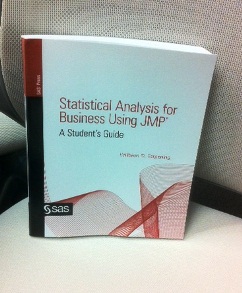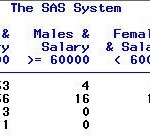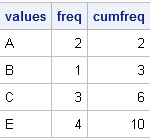All Posts

SESUG (Southeast SAS Users Group Conference) is an annual conference held in the Southeast US - typically in September or October. This year, the conference will be held at the Sheraton Imperial Hotel and Convention Center in Durham, North Carolina, October 14-16. According to Peter Eberhardt, SESUG 2012 Academic Chair, the

Remarkably, this week's tip was initially inspired by the Guinness Brewery in Dublin, Ireland. In his new book Statistical Analysis for Business Using JMP, Professor Willbann Terpening provides lots of useful information - including the origin and usage of the Student t-distribution. If you'd like to get to know Willbann and

Part of what captivated me about this paper and poster presentation were the presenters - these guys are high school kids using SAS to do a visual analysis of Internet use by high schoolers. The idea was so compelling that Anna Brown and Inside SAS Global Forum went to talk

The semester is coming to an end and summer break is just around the corner, so why should you be thinking about conferences and grant opportunities? Conferences like SESUG provide a lot of great benefits to students.

What tiny looking operator packs a mighty punch with large datasets? Your queries are big. Your reports span multiple columns. To top it all you have to summarize data in multiple ways. Are you tempted to throw in the towel? Do you feel like saying a firm “Can’t be done”

So, when you go to the game, do you buy a hot dog, a beer and a banner before the first quarter? Do you buy them all from the same vendor? Do you go back during the half? Does the score impact how much money you spend on concessions? All

When I was at SAS Global Forum last week, a SAS user asked my advice regarding a SAS/IML program that he wrote. One step of the program was taking too long to run and he wondered if I could suggest a way to speed it up. The long-running step was

Stanley Fogleman says that SAS can be hard to learn on your own - not because it is a difficult language - but because of the various business requirements. In fact, even college students entering the workforce are often ill-prepared in some ways. That's why Fogleman believes that a SAS mentoring program

With the rapid changes in our education systems regarding new standards, assessments, accountability and evaluation, teachers are rightfully feeling the pressure of being underprepared. The majority of teachers were not trained or certified with these rigorous systems in place. Recognizing that higher education institutions need to play an active role
At the 2012 SAS Global Forum, one of the questions from a user was about showing the original data used for the box plot. While you can use outliers in conjunction with the box features to get a feel for the data, for some situations you may need to see exactly

SAS already has some cool mobile Business Intelligence apps. Now, Scott McQuiggan tells Anna Brown, in this Inside SAS Global Forum interview, that you can view the really cool high-performance analytics reports that you've created on your desktop - right from your mobile device. Check this out!!

In statistical programming, I often test a program by running it on a problem for which I know the correct answer. I often use a single expression to compute the maximum value of the absolute difference between the vectors: maxDiff = max( abs( z-correct ) ); /* largest absolute difference

It is becoming more and more apparent that social media is a gold mine of unstructured data that is just waiting to be analysed so that the nuggets can be extracted. At SAS Global Forum, I was particularly impressed with the diversified use of sentiment analysis and the exploration that

Jenn Sykes (you probably remember her from this great sentiment analysis post last year about American Idol), presented Predicting Electoral Outcomes with SAS® Sentiment Analysis and SAS® Forecast Studio at SAS Global Forum 2012. In addition to predicting elections, Sykes tells Anna Brown from Inside SAS Global Forum, that there is a lot of unstructured data

A reader asked: I want to create a vector as follows. Suppose there are two given vectors x=[A B C] and f=[1 2 3]. Here f indicates the frequency vector. I hope to generate a vector c=[A B B C C C]. I am trying to use the REPEAT function







